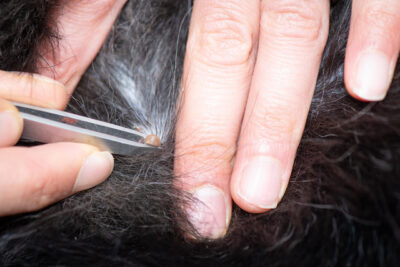Overview
Introduction to Lyme Disease in Dogs

Welcome to our comprehensive guide on Lyme disease in dogs. Understanding this condition is crucial for every dog owner, as Lyme disease can have serious consequences if left untreated. Lyme disease, also known as canine borreliosis, is a bacterial illness transmitted through the bite of an infected tick, specifically the deer tick.
This guide will provide you with all the essential information you need to know about Lyme disease in dogs, including its causes, symptoms, diagnosis, treatment, and prevention.
Whether you’re a seasoned pet owner or a new one, this guide aims to equip you with the knowledge to protect your furry friend against this potentially harmful disease.
A brief overview of Lyme disease in dogs
Lyme disease in dogs is a bacterial infection transmitted through the bite of an infected tick, particularly the deer tick. When an infected tick bites a dog, it can transmit the Borrelia burgdorferi bacteria, leading to Lyme disease.
Early detection and treatment are crucial, as Lyme disease can cause serious health issues if left untreated.

Importance of prevention and early detection
Prevention and early detection are key in managing Lyme disease in dogs. Regular tick checks and the use of tick preventatives can help reduce the risk of tick bites.
Additionally, prompt veterinary care and testing if a tick bite is suspected can lead to early diagnosis and treatment, improving the chances of a positive outcome for the dog.
Understanding Lyme Disease
What is Lyme disease?
Lyme disease is a bacterial infection caused by the bacterium Borrelia burgdorferi, transmitted through the bite of an infected black-legged tick, also known as a deer tick. These ticks become infected after feeding on small mammals, such as mice, which are reservoirs for the bacterium.
According to the Companion Animal Parasite Council, preventing tick bites and regular tick checks are crucial for reducing the risk of Lyme disease in both humans and animals.

How is it transmitted to dogs?
Lyme disease is transmitted to dogs through the bite of an infected tick, specifically the black-legged tick, which can carry the disease-causing bacteria, Borrelia burgdorferi. When an infected tick bites a dog, it can transmit the bacteria, leading to Lyme disease.
Dogs can also get Lyme disease from other infected dogs, although this mode of transmission is less common. Regular tick prevention measures and veterinary check-ups are essential to protect dogs from Lyme disease.
Areas where Lyme disease is prevalent
Lyme disease is prevalent in areas where infected ticks, specifically deer ticks, are common, such as wooded and grassy areas. In Florida, Lyme disease is less common, as the climate is not as favorable for deer ticks, and ticks are found less frequently in warmer weather and tall grasses.
However, in Ohio and Georgia, especially in rural and wooded areas, there is a higher risk of encountering infected ticks and contracting Lyme disease. Taking preventive measures, like using tick repellent and checking for ticks after outdoor activities, is important in these regions.

Symptoms and Signs of Lyme Disease
Common signs and symptoms of Lyme disease in dogs
Common symptoms of Lyme disease in dogs include kidney disease (Lyme nephritis), joint pain, swollen lymph nodes, joint swelling, generalized stiffness, weight loss, and lethargy.
Lyme disease is diagnosed by evaluating a dog’s symptoms, history of tick exposure, and blood tests for antibodies to the Lyme disease-causing bacteria. If Lyme disease is suspected, a veterinarian may recommend treatment with antibiotics to help manage the infection and reduce symptoms.
How symptoms can vary between acute and chronic cases
In dogs infected with Lyme borreliosis, symptoms can vary between acute and chronic cases. Acute cases often present with common signs such as swollen joints, fever, and lethargy, while chronic cases can lead to serious complications like kidney failure.
Dogs that have tested positive for Lyme disease and develop chronic symptoms, especially kidney failure, may have a poor prognosis and require prompt and intensive treatment.

Diagnosing Lyme Disease
Methods used by veterinarians to diagnose Lyme disease
Veterinarians diagnose Lyme disease in dogs through various methods, especially when the initial infection is suspected.
Besides assessing clinical signs and history of tick exposure, veterinarians rely on blood tests to confirm the presence of antibodies against the Lyme disease-causing bacterium.
Polymerase chain reaction (PCR) tests may also be used to detect the genetic material of the bacterium in the blood of dogs suspected of being infected.
Importance of early detection and treatment
Early detection and treatment of Lyme disease are crucial for ensuring the best outcomes for dogs. When Lyme disease is diagnosed early, treatment is more likely to be effective in eliminating the infection. Additionally, early detection can help prevent the spread of Lyme disease to other dogs and reduce the risk of complications associated with the infection.
Regular testing for Lyme disease, especially in areas where ticks that carry Lyme disease are prevalent, can help ensure early detection and prompt treatment. If your dog is itching excessively, it could be a sign of a tick bite, so it’s important to check for ticks and consult with your veterinarian if you notice any symptoms or changes in behavior.

Lyme Disease Diagnosed and Treatment Options
Antibiotics and other medications commonly used
Lyme disease is treated with antibiotics, commonly doxycycline or amoxicillin, which are prescribed based on the severity of the infection and the affected dog’s health status.
In addition to antibiotic treatment, preventive measures such as vaccination against Lyme disease and controlling ticks on the dog’s body and in their environment are crucial for disease control. A veterinarian can guide the best treatment options and preventive measures for dogs at risk of Lyme disease.
Duration of treatment and expected outcomes
Lyme disease in dogs is typically treated with antibiotics, with the duration of treatment depending on the severity of the infection. In most cases, dogs respond well to treatment and show improvement within a few days to weeks.
However, chronically infected dogs may require longer treatment periods and may not fully recover. Preventing Lyme disease through tick control and regular veterinary check-ups can help reduce the risk of dogs developing this and other tick-borne diseases.

Prevention
Vaccination for Lyme disease in dogs
Preventing Lyme disease in dogs can be achieved through vaccination, which helps protect dogs from contracting the disease. The Lyme vaccination is recommended for dogs living in or traveling to areas where Lyme disease is prevalent.
Alongside vaccination, tick control measures and regular grooming to check for ticks can further reduce the risk of Lyme disease and other tick-borne diseases in dogs.
Tick control measures for prevention
Tick control measures are essential for preventing Lyme disease in dogs and reducing the risk of ticks affecting people and other animals.
Regularly checking pets for ticks, including in and around the ears and throughout the dog’s fur, and using tick prevention products recommended by a veterinarian can help prevent Lyme disease transmission.
Additionally, maintaining a tick-free environment by keeping grass short and removing leaf litter can further reduce the risk of tick exposure.

Tick Removal
Proper techniques for safely removing ticks from dogs
When removing ticks from dogs, it’s crucial to use proper techniques to prevent ticks from breaking apart and leaving their mouthparts in the skin. Most dogs can have ticks safely removed by grasping the tick close to the skin with fine-tipped tweezers and pulling straight out with steady pressure.
Avoid twisting or jerking motions, as this can cause the tick’s mouthparts to break off and remain in the skin, potentially leading to infection.
Importance of quick and complete removal
Quick and complete removal of ticks is important for most dogs to prevent the risk of tick-borne diseases and potential complications. Leaving a tick attached to a dog’s skin increases the likelihood of the dog getting sick.
Proper tick removal techniques should be used to ensure the tick is completely removed, including its mouthparts, to reduce the risk of infection and promote the dog’s health.

Living with a Dog with Lyme Disease
Tips for caring for a dog with Lyme disease
When living with a dog with Lyme disease, it’s important to follow your veterinarian’s treatment plan, which may include antibiotics and supportive care.
Monitor your dog closely for any changes in behavior or health, and continue to prevent tick bites to avoid further complications.
How to manage the disease’s effects on a dog’s quality of life
To manage Lyme disease’s effects on a dog’s quality of life, provide regular veterinary care, including monitoring for symptoms and adjusting treatment as needed.
Keep your dog comfortable with a balanced diet, regular exercise, and a stress-free environment to help them maintain a good quality of life despite the disease.

Complications and Prognosis
Possible complications of Lyme disease in dogs
Complications of Lyme disease in dogs can include kidney damage, joint inflammation, and neurological issues.
With prompt diagnosis and treatment, many dogs can recover from Lyme disease, but severe cases can lead to long-term health issues or a poor prognosis.
Long-term prognosis for dogs with Lyme disease
The long-term prognosis for dogs with Lyme disease is generally good, especially with early diagnosis and appropriate treatment.
However, some dogs may experience chronic joint inflammation or kidney damage, which can affect their quality of life.
Conclusion to Lyme Disease in Dogs
Recap of key points about Lyme disease in dogs
Lyme disease, or canine borreliosis, is a bacterial illness transmitted through the bite of an infected tick, specifically the deer tick. Prevention and early detection are crucial, as Lyme disease can cause serious health issues if left untreated.
Symptoms can vary between acute and chronic cases, with common signs including fever, lethargy, swollen joints, and decreased appetite. Diagnosis involves evaluating symptoms, tick exposure history, and blood tests for antibodies. Treatment includes antibiotics, and prevention is key through vaccination and tick control measures.
Importance of vigilance and proactive care for dogs
Vigilance and proactive care are crucial for protecting dogs against Lyme disease. Regular tick checks, tick preventatives, and prompt veterinary care for suspected tick bites are essential.
Maintaining a tick-free environment and regular veterinary check-ups can help detect Lyme disease early and ensure prompt treatment, improving the chances of a positive outcome for the dog.
For quality puppies for sale in Florida and surrounding areas, check out our available puppies. Thoughtfully bred from reputable breeders, our puppies are healthy, friendly, and cared for as family, guaranteeing that your new family member will exceed expectations.
Frequently Asked Questions (FAQs) About Lyme Disease in Dogs
- Q: How is Lyme disease in dogs transmitted?
- A: Lyme disease in dogs is transmitted through the bite of an infected tick, particularly the black-legged tick or deer tick.
- Q: What are the signs of Lyme disease in dogs?
- A: Clinical signs of Lyme disease in dogs can include joint pain, lethargy, fever, swollen lymph nodes, and lameness. In severe cases, it can lead to kidney damage (Lyme nephritis).
- Q: How is Lyme disease treated in dogs?
- A: Lyme disease in dogs is typically treated with antibiotics. The duration of treatment depends on the severity of the infection and the dog’s response to treatment.
- Q: Can Lyme disease in dogs make them sick?
- A: Yes, Lyme disease can make dogs sick, especially if left untreated. It can lead to serious complications such as kidney damage.
- Q: Can Lyme disease in dogs affect other diseases?
- A: Lyme disease can complicate the management of other diseases in dogs, particularly if the dog has a weakened immune system.
- Q: Can Lyme disease affect a dog’s fur?
- A: Lyme disease itself does not directly affect a dog’s fur, but the symptoms and complications of the disease can impact overall health, including coat condition.
- Q: Is Lyme disease more common in certain regions, like the upper Midwest?
- A: Yes, Lyme disease is more common in regions where the black-legged tick is prevalent, such as the upper Midwest and the Northeastern United States.
- Q: How is Lyme disease diagnosed in dogs?
- A: Lyme disease in dogs is diagnosed through a combination of clinical signs, history of tick exposure, and blood tests to detect antibodies to the Lyme disease-causing bacteria.
- Q: Can Lyme disease in dogs affect people?
- A: While dogs can carry infected ticks into the home, they do not directly transmit Lyme disease to people. However, people can get Lyme disease from infected ticks.
- Q: Can dogs be re-infected with Lyme disease?
- A: Yes, dogs can be re-infected with Lyme disease if they are bitten by an infected tick again.
- Q: How can I prevent Lyme disease in my dog?
- A: Preventing Lyme disease in dogs involves using tick preventives, checking for ticks regularly, and avoiding areas where ticks are prevalent, especially in the upper Midwest and Northeastern United States.
- Q: Should I see a veterinarian if I find a tick on my dog?
- A: Yes, it’s a good idea to see a veterinarian if you find a tick on your dog, especially if it has been attached for more than 24 hours or if you live in an area where Lyme disease is prevalent.
- Q: What is the difference between ticks and ear mites?
- A: Ticks are external parasites that attach to the skin and feed on blood, while ear mites are tiny parasites that live in the ear canal and feed on ear wax and oils. Ticks can transmit diseases like Lyme disease, while ear mites primarily cause irritation and discomfort in the ears.




